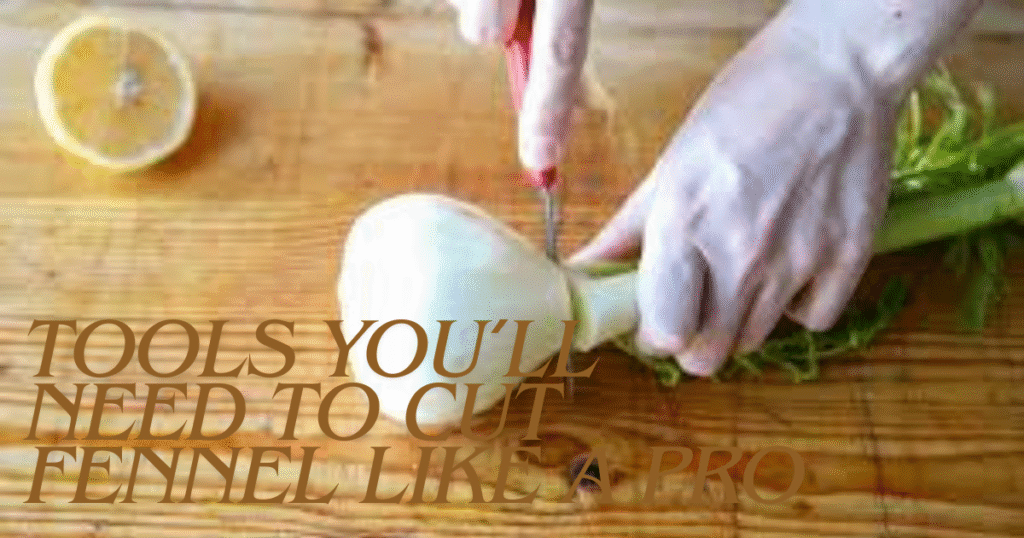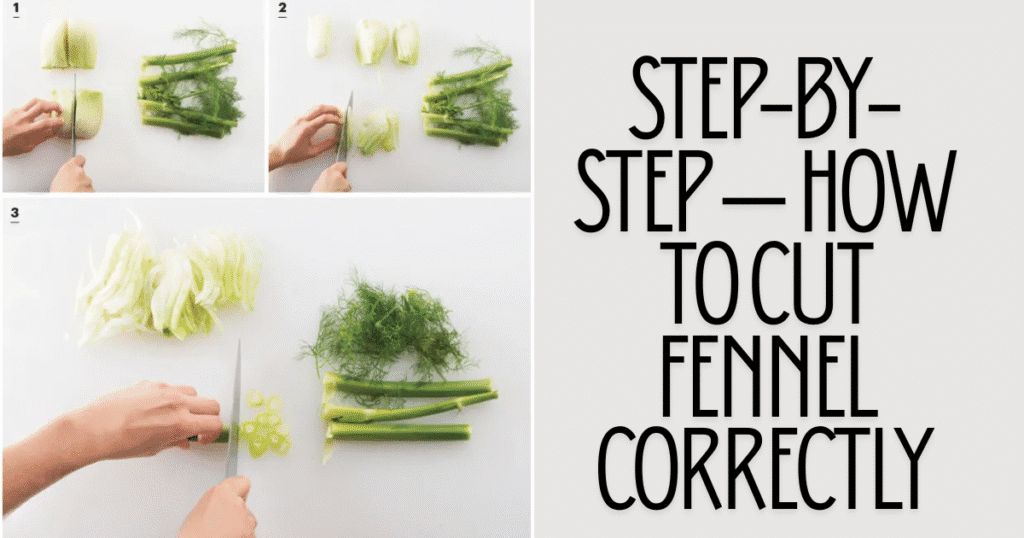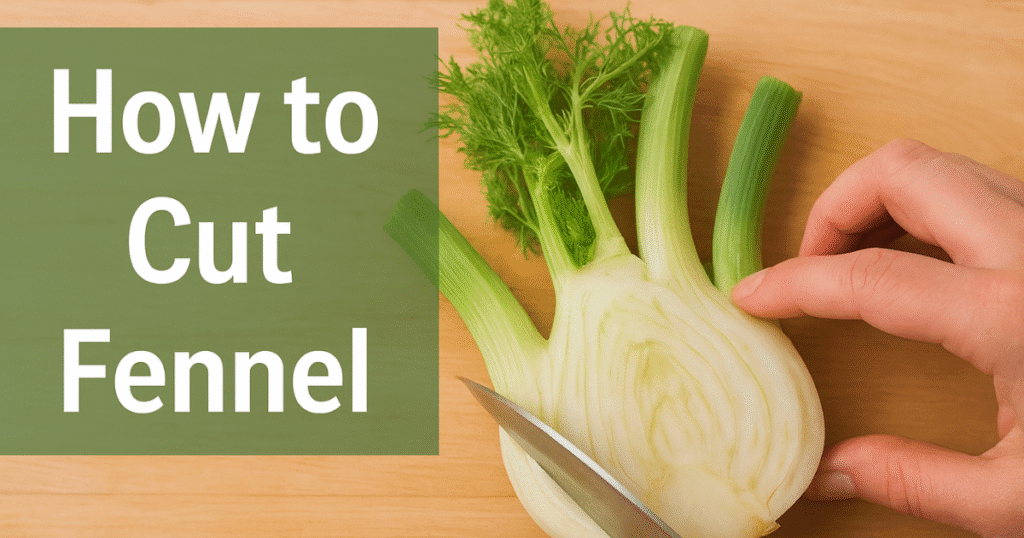Fennel is easy to love once you know how to cut fennel bulb the right way. This guide will walk you through every step — from trimming the stalks and fronds to slicing, dicing, and removing the core — so you can prepare fennel for salads, roasts, soups, and more. Read on for clear, friendly instructions, storage tips, common mistakes to avoid, and clever ways to use fennel fronds and stalks.
Quick Answer
To cut fennel, trim the stalks and fronds, slice the bulb in half, remove the core if needed, then slice or dice as your recipe requires. Use the fronds as garnish for extra flavor.
Tools You’ll Need to Cut Fennel Like a Pro

Before you start, gather a few simple tools to make cutting fennel fast and safe:
- A sharp chef’s knife (a dull knife makes uneven slices).
- A sturdy cutting board.
- Optional: mandoline slicer for paper-thin fennel slices.
- A small paring knife for trimming tricky bits.
Tip: A sharp knife and a stable board are the best fennel-cutting tools — they give you control and clean cuts whether you want to slice fennel thinly for salad or cut wedges for roasting.
Also Check: Why Is the Dream Diadem Bridal Lehe Trending in 2025?
Understanding Fennel Parts (Bulb, Stalks, Fronds, Core)

Before you learn how to prepare fennel, it helps to know what each part does:
- Bulb: The round, white base — crunchy and mildly sweet. This is the part most people cook and slice.
- Stalks: Long and fibrous; they have flavor and can be used in stocks or thinly sliced in recipes.
- Fronds: Feathery green tops that taste fresh and fennel-like — perfect as a garnish or in herb mixes.
- Core: A firmer, sometimes slightly woody center inside the bulb; many cooks remove it for tenderness, but you can keep it if you like a firmer bite.
Knowing the anatomy helps you cut fennel with purpose — saving edible parts, reducing waste, and getting the right texture for each recipe.
Step-by-Step — How to Cut Fennel Correctly

Follow these simple steps for consistent results. This section covers how to cut fennel for different uses, from salads to roasts.
Rinse and Dry
Rinse the fennel bulb under cold water to remove dirt, especially between layers. Pat dry with a kitchen towel. Removing moisture helps you slice fennel thinly and prevents slipping.
Trim Stalks and Save Fronds
Use your chef’s knife to cut off the long green stalks where they meet the bulb. Don’t throw them away — they’re great for stocks. Pull off the feathery fronds and save them as a fresh garnish or to mix into salads and dressings.
Cut the Base and Halve the Bulb
Trim a thin slice off the root end to create a flat surface. Place the fennel on that flat side for stability, then slice the bulb in half lengthwise through the core. This exposes the inner layers and makes it easy to remove the core.
Remove the Core (Optional)
If the core is tough or you want tender slices, lay each half cut-side down and run a paring knife in a V-shape to remove the triangular core. For salads where thinness matters, removing the core helps you slice uniformly.
Slice, Dice, or Shave
- For salad (how to cut fennel for salad): Use a mandoline or slice thinly with a sharp knife. Thin slices highlight fennel’s crisp texture.
- For roasting: Cut the bulb into thick wedges so the layers hold together during cooking.
- For soups or stews: Dice into small pieces so fennel softens quickly and distributes flavor.
- For garnish: Chop fronds or snip them finely to sprinkle over dishes.
Tools You’ll Need to Cut Fennel Like a Pro
| Tool | Purpose | Tips |
|---|---|---|
| Chef’s knife | For slicing, dicing, and trimming | Keep it sharp for clean, safe cuts |
| Cutting board | Stable surface for cutting | Non-slip or damp cloth under board |
| Mandoline slicer | For ultra-thin slices | Always use hand guard |
| Paring knife | To remove the core | Useful for small precise cuts |
Tip: A sharp knife and steady board are the best fennel-cutting tools — they keep slices neat and safe whether you’re cutting fennel thinly for salad or wedges for roasting.
Understanding Fennel Parts (Bulb, Stalks, Fronds, Core)
Before you learn how to prepare fennel, it helps to know what each part does:
| Fennel Part | Description | Best Use |
|---|---|---|
| Bulb | Crisp, white base with a mild anise flavor | Slice thin for salads or roast in wedges |
| Stalks | Long and fibrous | Great in soups or stocks for flavor |
| Fronds | Feathery, green tops | Use as garnish or in dressings |
| Core | Firm inner center | Remove for tenderness or keep for firmness |
Understanding the anatomy helps you cut fennel with purpose — saving edible parts and reducing waste.
How to Cut Fennel for Different Recipes
| Recipe Type | Cut Style | Cooking Tip |
|---|---|---|
| Salad | Paper-thin slices | Toss with citrus and olive oil |
| Roasting | Thick wedges | Drizzle oil and roast at 400°F |
| Soups/Stews | Small dice | Add early to develop flavor |
| Grilling | Thick slices | Brush with oil to prevent sticking |
| Garnish | Chopped fronds | Sprinkle for freshness |
Each method brings out a different flavor and texture from fennel.
Fennel Storage Tips & How to Keep It Fresh

- Store whole fennel in a plastic bag in the crisper drawer for up to a week.
- After cutting, keep it in an airtight container for 2–3 days.
- To keep slices crisp, store upright in cold water.
- Blanch before freezing if using for cooked dishes.
- Revive wilted fennel by soaking in ice water.
Also Check: MrBeast’s $1 to $500,000 Date Challenge
Common Mistakes to Avoid
- Cutting with a dull knife — causes uneven slices.
- Discarding fronds — they’re flavorful!
- Not stabilizing the bulb before cutting.
- Cutting too far into the root — wastes edible parts.
Quick Chef Tips
- Chill the bulb before slicing for crisp salads.
- Use lemon juice to balance the flavor.
- Save stalks for soup stock.
- Combine fennel with oranges or apples for a fresh twist.
Bonus: How to Use Fennel in Mediterranean Dishes
Fennel fits beautifully in Mediterranean recipes — roasted with olive oil and garlic, mixed with citrus in salads, or added to fish dishes. Use the fronds in sauces, and stalks in soups for layered flavor.
How to Cut Fennel for Different Recipes
Different dishes need different cuts. Here’s a quick recipe-focused guide:
- Raw salads: Paper-thin slices pair beautifully with citrus and olives. Toss with lemon juice and olive oil.
- Roasted fennel: Quarter the bulb into wedges, drizzle with oil, and roast until caramelized. Thick wedges resist overcooking.
- Soups and stews: Small dice adds body and flavor. Sauté diced fennel with onions as a base.
- Grilled or pan-seared: Cut into thick slices or wedges to maintain structure on the grill.
- Garnish and pesto: Use fronds as a fresh herb or blend them into a light pesto for fish or sandwiches.
Including these options in your cooking ensures you’re preparing fennel in the best way for the dish.
Fennel Storage Tips & How to Keep It Fresh
- Whole fennel: Store in the refrigerator crisper drawer, unwashed, in a plastic bag. It keeps fresh for up to a week.
- After cutting: Wrap cut fennel tightly in plastic or airtight container; it should last 2–3 days. Store sliced fennel upright in a jar of cold water for extra crispness for a day or two.
- Freezing: Not ideal for raw salads, but you can blanch and freeze fennel for cooked dishes. Texture will change.
- Revive wilted fennel: Soak in ice water for 15–30 minutes to perk it up before slicing.
Good storage keeps fennel flavorful and prevents waste.
Common Mistakes to Avoid When Cutting Fennel
- Using a dull knife — leads to uneven slices and crushed layers.
- Cutting too close to the root — you may leave dirt or waste edible parts.
- Over-trimming the fronds — they’re flavorful and useful as garnish.
- Not stabilizing the bulb — always create a flat surface so the fennel doesn’t roll.
Avoiding these mistakes makes cutting fennel faster and safer.
Quick Chef Tips for Perfect Fennel Every Time
- Chill the bulb before slicing for extra crispness in salads.
- Use the mandoline for picture-perfect thin fennel slices, but use a guard to protect fingers.
- Balance fennel’s anise notes with citrus or acid (lemon juice or vinegar) for brighter flavor.
- Save stalks for stocks or braises to extract more fennel flavor in cooked dishes.
- If you want a milder flavor, gently blanche slices in boiling water for 30 seconds, then shock in ice water.
These small tricks lift ordinary fennel into something memorable.
Bonus: How to Use Fennel in Mediterranean Dishes
Fennel shines in Mediterranean cooking. Toss thin fennel slices with orange segments, olives, and a lemon-olive oil dressing for a bright fennel-citrus salad. Roast wedges with garlic and rosemary as a savory side. Use fronds as a herb substitute in fish recipes or mix them into a green pesto. Even the stalks can flavor a vegetable stock for soups. These ideas show how to use the whole fennel bulb without waste.
Frequently Asked Questions
What part of fennel do you eat?
You can eat the bulb, stalks, and fronds. The bulb is most commonly used cooked or raw.
Can you eat fennel raw?
Yes — raw fennel is crisp and slightly sweet, excellent in salads and slaws.
How do you store fennel after cutting?
Keep it in an airtight container in the fridge for 2–3 days, or store slices upright in cold water for extra crispness.
What’s the easiest way to cut fennel thinly without a mandoline?
Use a sharp chef’s knife and steady, even strokes, holding the fennel firmly and guiding the blade with your knuckles.
Final Thoughts — Fennel Made Simple
Learning how to cut fennel is a small skill that opens up many delicious options. Whether you’re slicing fennel thinly for a crunchy salad, cutting wedges for roasting, or saving fronds for garnish, these steps will help you prepare fennel with confidence. Keep your knife sharp, save the fronds, and experiment with lemon and olive oil to bring out fennel’s bright, slightly sweet flavor. Happy cooking — and enjoy the fresh crunch of fennel in your next Mediterranean dish.

